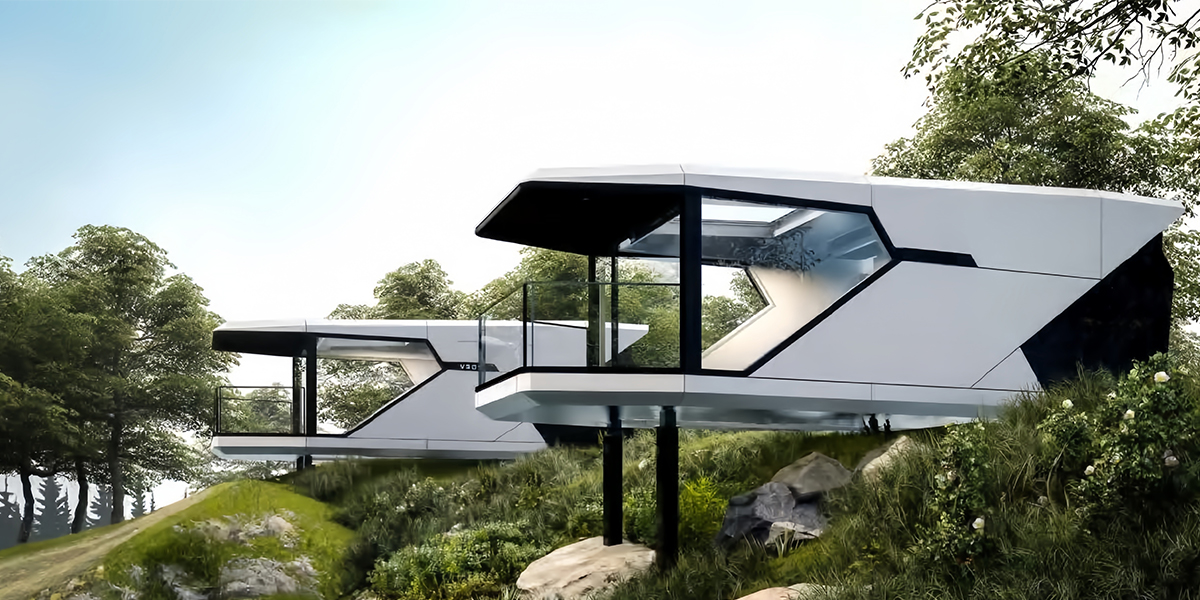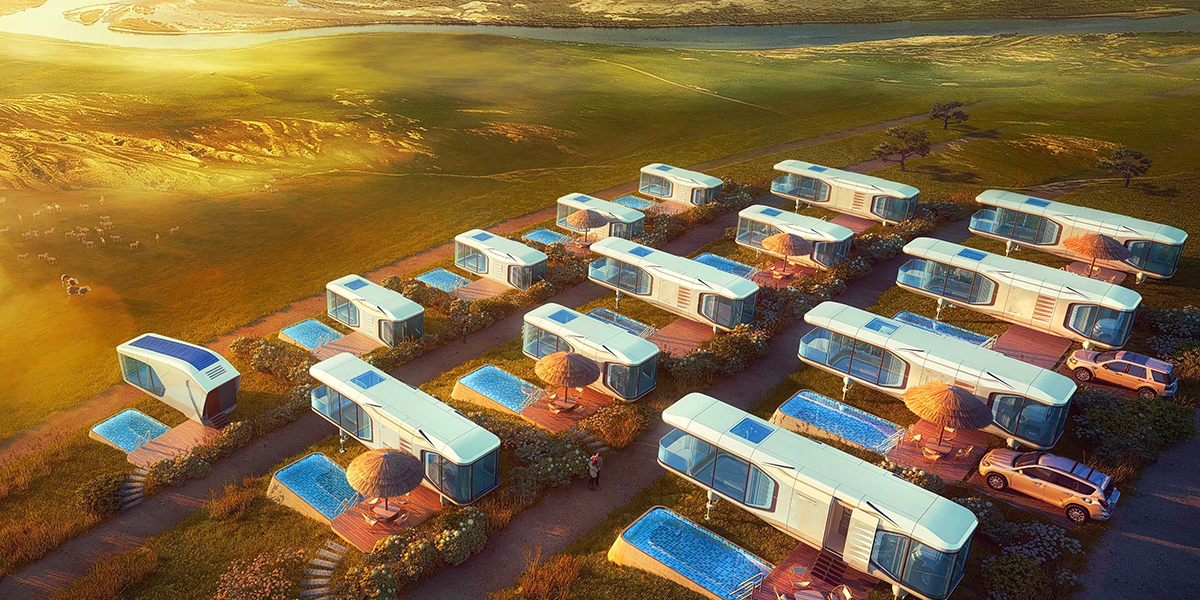
06 Jul Discover the Basics of Capsule Homes and Their Benefits
Table of Contents
A capsule home is a small and modern place to live. Designers often get ideas from space pods. This makes capsule homes look cool and simple. You can find smart designs that make small homes feel cozy. Many people pick capsule homes because they save space, cost less, and are easy to move. These homes use less energy and fewer materials. Living in one helps the planet. Capsule homes are good for people who want a simple life and use all their space.
Key Takeaways
Capsule homes are small, modern houses. They use space in a smart way. This makes the living area cozy and efficient. These homes help save money and energy. They use fewer materials and strong insulation. They also use green technology like solar panels. Capsule homes are flexible because of their modular designs. You can move them to new places if needed. Living in a capsule home helps the planet. It lowers energy use and waste. Space is limited and there may be legal rules. But capsule homes are good for people who want simple, cheap, and eco-friendly living.
What Is a Capsule Home
Definition
A capsule home gives you a compact and efficient way to live. You get a small space that uses every inch wisely. Designers create each capsule house to feel modern and simple. You often see shapes like rectangles or cylinders. Most capsule houses measure between 300 and 500 square feet. You can find a capsule tiny house with an open floor plan. This makes your living area feel bigger than it is.
You will notice that a capsule house uses smart storage. Beds, tables, and shelves often fold away or hide inside walls. You can move a capsule tiny house to new locations if you want. Many people choose a capsule home because it saves money and energy. You also help the planet by using fewer resources. Capsule houses often use solar panels and energy-saving systems. You get a home that is both stylish and practical.
Tip: If you want to live with less clutter, a capsule tiny house helps you focus on what matters most.
Origins
The idea for a capsule home started in Japan. In the 1970s, Japan built capsule hotels for travelers who needed a cheap and quick place to sleep. These capsule houses gave each person a small pod with a bed and basic needs. Over time, people saw that a capsule tiny house could work for daily living too.
Designers took the idea of the capsule house and made it better. They added kitchens, bathrooms, and living spaces. Now, you can find capsule houses in many countries. Some people use a capsule tiny house as a main home. Others use it as a guest house or vacation spot. The design of capsule houses keeps changing. Today, you see capsule tiny house models that use new materials and smart technology.
Capsule houses now fit many lifestyles. You might want a capsule tiny house for city living, or you might want to travel with your home. Capsule houses give you choices that fit your needs. You can enjoy a simple life with everything you need in a small space.
Capsule House Features
Design
A capsule house looks different because of its creative design. Most capsule houses are shaped like boxes or cylinders. These shapes help save space and look modern. A capsule tiny house is usually 300 to 500 square feet. The open layout makes the space feel bigger. The simple style keeps your home neat and easy to clean.
Capsule houses are made with modular parts. You can add or take away sections as needed. This lets you change your space when your life changes. Many people pick a prefab house because the parts are made in a factory. This saves time and cuts down on waste. You can choose different finishes and layouts for your capsule tiny house. Customisation lets you control how your space looks and works.
Tip: A capsule tiny house with a simple look helps you focus on what is important.
Technology
Capsule houses use advanced technology to be green and eco-friendly. Builders use strong materials and smart systems for comfort. Prefab house building often uses solar panels and energy-saving tools. You pay less for utilities and help the planet.
Here is a table that shows some main features and how they help save energy:
Feature | Specification / Metric | Impact on Energy Efficiency and Sustainability |
|---|---|---|
Thermal Resistance | 3.2 m²·K/W (polyurethane foam + extruded board) | Six times better than normal materials; keeps heat in and cuts heating costs |
Air Tightness | n50 = 0.45 | Stops air leaks, keeps heat inside, and saves energy |
Window Technology | Double/triple pane Low-E glass | Blocks heat loss, keeps rooms warm, and lowers energy use |
Energy Efficiency Gain | 65% more efficient than regular buildings | Uses much less energy and is better for the environment |
Service Life | Over 50 years | Lasts a long time, so you use fewer resources |
Capsule tiny house windows have double or triple panes. This keeps the inside warm and blocks UV rays. The prefab house has insulated walls and floors. Your home stays quiet, warm, and green. Builders can set up your capsule house fast. They use foot pads and cranes to put it almost anywhere. Prefab house methods make moving and setting up easy.
- Double tempered hollow Low-E windows help save energy.
- Triple pane windows give more insulation for very cold or hot places.
- Prefab house building helps the planet and makes homes last longer.
A capsule tiny house is a smart, green, and flexible way to live.
Benefits of Capsule Homes
Affordable Living
Capsule homes are a good way to save money. They are built fast and do not cost much. Builders use fewer materials and less work. This makes them cheaper for people who want simple living. You do not have to pay high utility bills. The small size means you pay less for heat and power. Many people think capsule homes are smart and save money. You also spend less on repairs because the design is simple. If you want a home that does not cost much, capsule homes are a smart pick.
Note: Capsule homes help you save money and stick to your budget.
Sustainability
Capsule homes are good for the planet. Builders use green materials and energy-saving systems. You help the earth by picking a home with less impact. Many capsule homes have solar panels and good insulation. These things help you use less energy and live green. Living in a small space also lowers your carbon footprint. Green designs make capsule homes a top pick for people who care about nature. You can feel proud that your home is green and helps the earth.
Here is a table showing how capsule homes help the environment:
Feature | Eco-Friendly Impact |
|---|---|
Solar Panels | Lower energy use |
Smart Insulation | Less heat loss |
Small Size | Reduced carbon footprint |
Green Materials | Less waste and pollution |
Space Efficiency
Capsule homes use space in a smart way. Designers make sure every inch is useful. You get hidden storage, beds that fold away, and smart layouts. This makes capsule homes green and comfy. You can move or change your home easily. This gives you more choices as your needs change. You also pay less for utilities and repairs because you use less space. Capsule homes are green, cheap to build, and let you live how you want.
Tip: If you want a home that is green, cheap, and easy to care for, capsule homes are a great choice.
Challenges of Capsule Houses
Limited Space
You will notice that capsule houses give you less room than regular homes. You may find it hard to store all your things. You might need to give up some hobbies or large furniture. Living in a small space can also mean less privacy. If you share your capsule home, you may hear more noise and have fewer quiet spots.
Tip: Try using multi-purpose furniture and keep only what you need. This helps you make the most of your space.
Some people feel stressed in small spaces. You may need time to adjust to a new way of living. If you like to host big gatherings, a capsule house may not fit your needs.
Legal Issues
Capsule houses face rules that can make building or living in them hard. Many cities have zoning laws that limit where you can place a small home. Some places do not allow capsule homes as main houses. You may need special permits or face extra fees.
Here is a table showing common legal challenges:
Challenge | What It Means for You |
|---|---|
Zoning Laws | May stop you from placing your home |
Building Codes | Set rules for safety and design |
Permits | Needed for setup and utilities |
You should check local laws before you buy or build a capsule house. This helps you avoid problems later.
Maintenance
Capsule houses need care to last a long time. Most last between 25 and 50 years if you keep them in good shape. You must check for leaks, clean vents, and fix small problems fast. The small size makes cleaning easy, but you cannot ignore repairs.
Note: Regular upkeep keeps your capsule home safe and comfortable.
You may need to replace parts like seals or windows over time. If you move your home often, check the structure after each move. Taking care of your capsule house helps it last and keeps you happy in your space.
Capsule Houses: Uses & Costs
 Common Uses
Common Uses
Capsule houses can be used in many ways. Many people pick them for city living because they fit in small spaces. Some people use a capsule house as a vacation home. You can put one near the beach, in the mountains, or in your backyard. Capsule houses are good for people who want to move often. You can take your home to new places when you want a change. These homes are good for the planet and help you live with less waste. You can also use a capsule house as a guest house or a studio for work or hobbies.
Who They Suit
Capsule houses work for many people. If you live alone or with a partner, you will find a capsule house cozy and not too expensive. Many people who care about the earth choose capsule houses because they use less energy and fewer materials. People who move for work like capsule houses because they can take their home with them. If you want to save money and live simply, a capsule house is a good choice. You can also pick custom options to make your space fit your needs. Capsule houses help you live green and spend less.
Tip: If you want a green home that fits your style, look for custom options in your capsule house.
Price Range
The price of a capsule house depends on size, materials, and custom options. Most capsule houses cost between $20,000 and $100,000. You pay less for a simple model and more for extra features or green upgrades. The price also covers delivery and setup. You save money on bills because capsule houses use less energy. It costs less to keep up because the design is simple. If you want to spend less, pick only the features you need. Always plan your budget before you buy. Capsule houses give you a cheap and green way to own a home.
Factor | How It Affects Costs |
|---|---|
Size | Bigger homes cost more |
Materials | Eco-friendly costs more |
Customisation | Extra features add to price |
Location | Delivery costs can vary |
Capsule homes give you a smart way to live with less. You get a modern space that saves money and energy. These homes use clever designs and green technology. You may face challenges like limited space or legal rules. Think about your lifestyle and budget before you choose capsule homes. If you want to learn more, talk to experts or visit a model home. Capsule homes might be the right choice for your future.
FAQ
What is the lifespan of a capsule home?
Most capsule homes last between 25 and 50 years. You can make your home last longer with regular care and quick repairs. Good materials and smart design help your home stay strong.
Tip: Check your home each year for leaks or damage to keep it in top shape.
Can you move a capsule home to a new location?
Yes, you can move most capsule homes. Builders design them to be portable. You may need a crane or special truck for moving. Always check local rules before you move your home.
Do capsule homes stay warm in winter and cool in summer?
Capsule homes use strong insulation and special windows. These features help keep your home warm in winter and cool in summer. You save energy and stay comfortable all year.
Feature | Benefit |
|---|---|
Insulation | Keeps heat inside |
Low-E Windows | Blocks heat loss |
Are capsule homes safe during storms?
Capsule homes use sturdy materials and strong frames. Many models can handle wind and rain. You should ask the builder about safety features for your area. Always follow local safety rules.
Can you customize the inside of a capsule home?
You can choose different layouts, colors, and features. Many builders let you pick storage, lighting, and finishes. Custom options help you create a space that fits your style and needs.
Note: Custom features may change the price of your capsule home.




 Common Uses
Common Uses